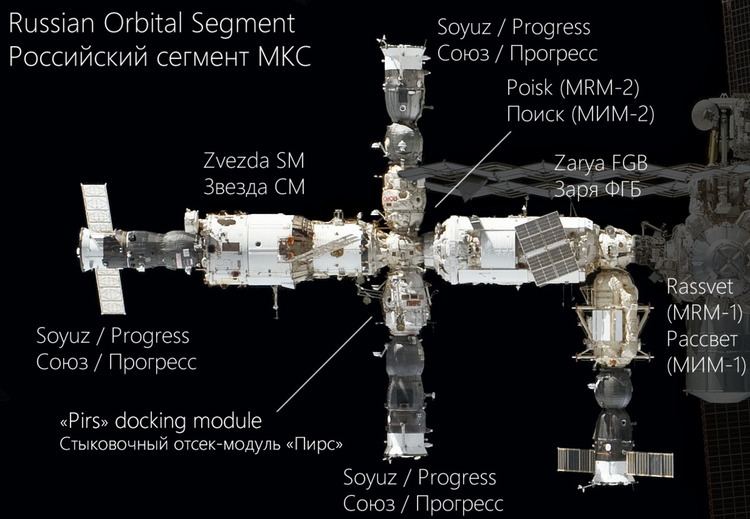Crew 2 or more | Launch 2020s Atmospheric pressure 1 atm | |
 | ||
Mass over 100,000 kg when complete Perigee 370 to 450 km (planned) | ||
The Orbital Piloted Assembly and Experiment Complex (Russian: Орбитальный Пилотируемый Сборочно-Экспериментальный Комплекс, Orbital'nyj Pilotirujemyj Sborochno-Eksperimental'nyj Kompleks) (ОПСЭК, OPSEK) is a Russian proposed third-generation modular space station in Low Earth orbit. OPSEK would initially consist of modules from the Russian Orbital Segment of the International Space Station (ISS).
Contents
The proposal would use OPSEK to assemble components of manned interplanetary spacecraft destined for Mars, the Moon, and possibly Saturn. The returning crew would also recover on the station before landing on Earth. This OPSEK could form part of a future network of stations supporting manned exploration of the Solar System.
Overview
Before the predicted decommissioning of the International Space Station in the 2020s, the Russian Federal Space Agency (Roscosmos) plans to detach some of its modules, such as the Multipurpose Laboratory Module (which has not yet launched to the ISS), and use them as the basis for a new space station.
On 17 June 2009, Roscosmos officially informed its ISS partner NASA about its intention to "build and prepare for operation the first elements of the orbital assembly and experimental piloted space complex by the end of the ISS life cycle."
According to the Russian manned spaceflight contractor RKK Energia, the new station must be able to perform the following tasks:
Structure
OPSEK will follow the Salyut and Almaz series, Cosmos 557, and Mir as the 12th Russian space station launched. OPSEK is a third generation modular space station.
Other examples of modular station projects include the Soviet/Russian MIR, the International Space Station, Tiangong 3, and the Chinese space station. The first space station, Salyut 1, and other one-piece or "monolithic" first generation space stations, such as Salyut 2,3,4,5, DOS 2, Kosmos 557, Almaz, and NASA's Skylab station, were not designed for re-supply. Generally, each crew had to depart the station to free the only docking port for the next crew to arrive. Skylab had more than one docking port but was not designed for resupply. Salyut 6 and 7 had more than one docking port and were designed to be resupplied routinely during crewed operation. Modular stations can allow the mission to be changed over time and new modules can be added or removed from the existing structure, allowing greater flexibility.
Modules
Expected Russian Orbital Segment modules around the time of OPSEK separation (2020 or later) arranged by launch dates:
Poisk (Russian: По́иск; lit. Search), also known as the Mini-Research Module 2 (MRM 2), Малый исследовательский модуль 2, or МИМ 2. Poisk is a Russian airlock module with two identical hatches. Its predecessor, Pirs, is used to store, service, and refurbish Russian Orlan suits. The outermost docking ports on both airlocks allow docking of Soyuz and Progress spacecraft, and the automatic transfer of propellants to and from storage on the station.
Nauka (Russian: Нау́ка; lit. Science), also known as the Multipurpose Laboratory Module (MLM) or FGB-2, (Russian: Многофункциональный лабораторный модуль, or МЛМ), is the major Russian laboratory module. This module will be separated from the ISS before de-orbit with support modules to become the OPSEK space station. It contains an additional set of life support systems and orientation control. Nauka's mission has changed over time; during the mid-1990s it was intended as a backup for the first FGB, and later as a universal docking module (UDM). Its docking ports will be able to support automatic docking of both spacecraft, additional modules and fuel transfer. Prior to the arrival of the MLM, a Progress robotic spacecraft will dock with the ISS PIRS module, depart with that module, and both will be discarded. Nauka will then use its own engines to attach itself to the ROS after 2014. The European Robotic Arm, which will service the Russian Orbital Segment, will be launched alongside the MLM.
Node Module (UM)/(NM) This 4-ton ball shaped module will support the docking of two scientific and power modules during the final stage of the station assembly and provide the Russian segment additional docking ports to receive Soyuz TMA (transportation modified anthropometric) and Progress M spacecraft. NM is to be incorporated into the ISS in 2016. It will be integrated with a special version of the Progress cargo ship and launched by a standard Soyuz rocket. The Progress would use its own propulsion and flight control system to deliver and dock the Node Module to the nadir (Earth-facing) docking port of the Nauka MLM/FGB-2 module. One port is equipped with an active hybrid docking port, which enables docking with the MLM module. The remaining five ports are passive hybrids, enabling docking of Soyuz and Progress vehicles, as well as heavier modules and future spacecraft with modified docking systems. More importantly, the node module was conceived to serve as the only permanent element of OPSEK. Equipped with six docking ports, the Node Module would serve as a single permanent core of the future station with all other modules coming and going as their life span and mission required. Uzlovoy will be launched after Nauka MLM; launch dates will be 2017 or later
ROS Modules not utilized in OPSEK
Russian Orbital Segment modules scheduled for de-orbiting:
Russian Orbital Segment modules that are neither scheduled for de-orbit nor included in the OPSEK proposals:
